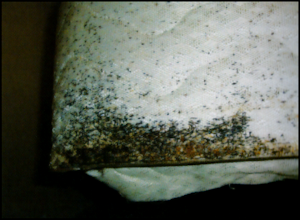



Bedbugs can be found all over the world. They were common in the U.S. before
World War II and became rare after widespread use of the pesticide DDT which
began in the 40s and 50s. At that time they remained constant in other areas of
the world and, in recent years, have been increasingly observed again in the U.S.
Bed bugs are a small, oval parasitic insect which feeds exclusively on the blood
of humans or animals. The adult bed bug is reddish brown in color, appearing
more reddish after feeding on a blood meal. Nymphs are clear in color and
appear bright red after feeding. Bedbugs do not fly, however, they are able to
crawl very rapidly.
Bed Bugs can live anywhere in the home, however, they tend to be most common in areas where people sleep and generally concentrate in beds, including the mattress, box springs, and bed frames. They can also reside in curtains, edges of carpet, corners and cracks of wooden furniture or in the upholstery of sofas and chairs. They thrive in temperatures between 70 F-80 F whcih allows them to develop into adults most rapidly and they can produce up to three generations per year. Since bedbugs can live for months or even longer under favorable conditions without feeding, they can also be found in vacant homes.


Bedbugs are most active at night. They may bite any exposed areas of skin while
an individual is sleeping. Common locations for bedbug bites are on the face,
neck, hands, and arms. A bedbug bite is painless and generally goes unnoticed.
The bites will produce redness, minor swelling and itching and may be mistaken
for a rash of another cause. Typically, no treatment is required for bedbug bites. If
the itching is severe, steroid creams or oral antihistamines may be used for
symptom relief.
Fecal stains, egg cases, and the shed skins of bedbugs in crevices and cracks on
or near beds are suggestive that bedbugs may be present, but only observing the
bugs themselves can confirm an active infestation. Southwestern A-1 Pest Control
can help homeowners identify and remove bedbugs from their home.

BEDBUGS
LEARNING CENTER




